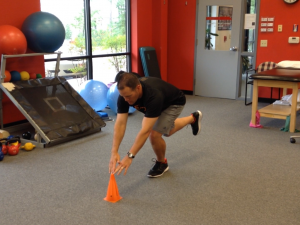Brian Schiff’s Blog
Injury Prevention, Sports Rehab & Performance Training Expert
As we age, balance steadily declines. This exercise is an effective and fun way to challenge balance and increase lower body strength. I typically incorporate it for clients dealing with patellofemoral knee pain, glute and hip dysfunction as well as anyone struggling with dynamic limb stability. Watch the video below and give it a try yourself!
The idea behind this exercise is applying progressive gradients of resistance that encourage the faulty motion (pulling the leg into adduction and internal rotation) to facilitate increased activation of the gluteus medius/minimus and small lateral rotators to create an anti-adduction/internal rotation force by forcing the brain to work against the unwanted motion (better central nervous system activation). Decreasing such moments at the knee will reduce IT Band issues, patellofemoral pain, ACL injury risk and overuse problems often seen in running.
The video below from my online column for PFP magazine demonstrates how to execute this exercise. It is a great corrective and prehab training activity.
One of the biggest challenges for clients overcoming knee injuries and surgery is regaining their quadriceps strength and fighting atrophy. This is increasingly so for my clientele on crutches for any extended period of time. It is paramount to use modalities early on in the rehab process such as electrical stimulation and blood flow restriction training to combat atrophy and loss of strength.
Once appropriate, I always move to single limb training to eliminate imbalance and asymmetry. While pistol squats are one of the most effective single leg quadriceps exercises, not all clients can perform this movement. So, in many cases I opt to use a single leg box squat (see video below).
For more information on specific progressions and regressions, click here to read my entire online column. Keep in mind that you should never force through any painful range of motion as this likely indicates excessive strain on the patellofemoral joint.
Improving proximal hip stability and reducing frontal plane collapse is critical for protecting the knee. Poor frontal plane control often contributes to anterior knee pain, IT band syndrome, shin splints, plantar fasciitis and other injuries. This exercise is an advance progression of the standing pallof press, and it is very effective for enhancing single leg strength as well as hip/core stability.
Click here to read my full column on this exercise in PFP Magazine.
Whether doing prehab, rehab or training, I believe in using single leg exercises to attack asymmetries, imbalances and motor deficits I uncover in my assessments. Learning to control one’s body in space with the effect of gravity in a weight bearing position is instrumental for sport and injury prevention.
Furthermore, facilitating ankle mobility and proper knee alignment during a loaded squat pattern is something most athletes and clientele I work with need some help with. to that end, I utilize several different single leg reaching progressions and exercises. One of my favorite ‘go to’ exercises is the anterior cone reach.
I recently featured this specific exercise in my ‘Functionally Fit’ column for PFP Magazine. Click here to see the video demonstration.
This is a great exercise with progressions and regressions for clients of all ages and abilities.


